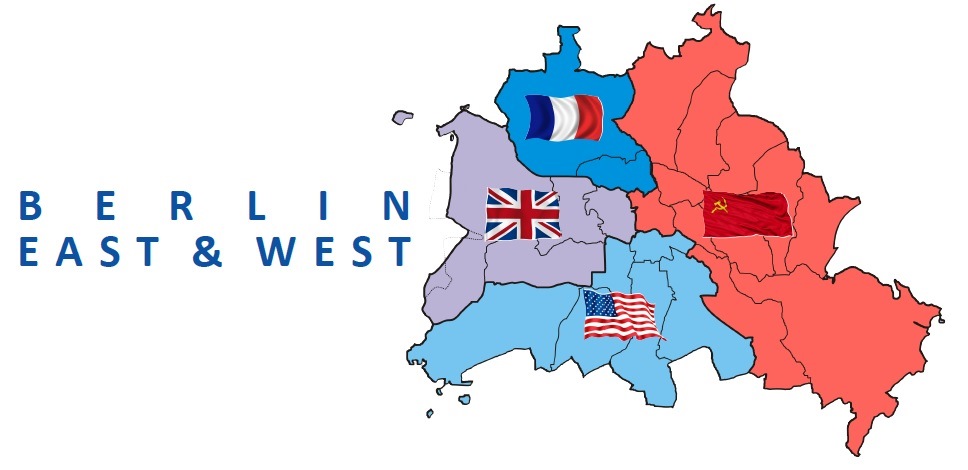| Europe is therefore divided into two large ideological blocks, separated by it “Iron Curtain”, of which the Berlin Wall is part. We also see a division in the military field: The United States and their allies focus NATO (Northern Atlantic Convention Organization) The Soviet Union and its allies are grouping in the Warsaw Pact. |
As a result, Europe was split into two ideological blocs, separated by the “Iron Curtain”, which the Berlin Wall was part of. At military level, the world was also divided: the USA and its allies created NATO (North Atlantic Treaty Organisation), while the USSR and its allies reacted by signing the Warsaw Pact. |
Europe is therefore torn into two large ideological blocks, separated by an "iron curtain", of which the Berlin Wall is part. Military, We are also witnessing a fracture : the United States and its allies create NATO (Organization of the Northern Atlantic Treaty), while the USSR and its allies react by signing the Warsaw Pact. |
| One of the most striking features of the Cold War is the war between Western and Communist Intelligence Services, Such as the American CIA and the Russian KGB. A few armed conflicts are also accompanied by that, o.a. in Korea, Vietnam an Afghanistan. The world is on the edge of a nuclear war a few times, such as during the Cubacrisis 1962. Fortunately, the worst can be avoided by diplomatic intervention. |
One of the most striking characteristics of the Cold War was the struggle between the western and the communist secret services, e.g. the CIA and the KGB. Many armed conflicts broke out, as is illustrated by the war in Korea, Vietnam and Afghanistan. On several occasions, the world was on the edge of slipping into a nuclear war, like in 1962 during the Cuban missile crisis. Yet, diplomatic intervention fortunately managed to avoid the worst. |
One of the most remarkable elements of the Cold War is that it is characterized by the fight delivered between Western and Communist Intelligence Services, Like the CIA and the KGB. Many armed conflicts burst, such as wars in Korea, in Vietnam and Afghanistan. Repeatedly, The world goes to the verge of nuclear conflict, as during the Cuba missile crisis in 1962. Fortunately, Diplomatic intervention manages to avoid the worst. |
| In the 1980s we see a flare -up of the Cold War with the arrival of two fiery, neo -liberal leaders in the United States (Ronald Reagan) and in the United Kingdom (Margaret Thatcher). Reagan raises the defense budgets and starts a new weapon race. The Soviet Union is now struggling with a serious economic crisis and cannot follow the new arms race. Russian President Gorbachov tries to control the crisis with various socio-economic measures and thereby unconsciously gives the impetus for the fall of the Soviet Union. In 1989 The wall of Berlin falls, The symbol for the separation between East and West. Shortly thereafter, the dismantling of the Warsaw Pact follows. The Cold War is over. |
In the 1980s, the Cold War flared up with the arrival of two staunch neoliberal leaders, i.e. Ronald Reagan in the USA and Margaret Thatcher in the UK. Reagan boosted the defence budget and initiated a new arms race. At the same time, the Soviet Union faced an acute economic crisis, and could therefore not rival with the USA. Then Soviet President Mikhail Gorbachev tried to defuse the crisis by adopting several socio-economic measures, but he thereby unwillingly triggered the fall of the USSR. 1989 marked the fall of the Berlin Wall, which symbolised the separation between the East and the West. This was soon followed by the dissolution of the Warsaw Pact. The Cold War was over. |
In the years 1980, The arrival of two ardent neoliberal leaders, Ronald Reagan in the United States and Margaret Thatcher in the United Kingdom, fits tensions. Reagan considerably increases the budget dedicated to defense and engages in a new arms race. For its part, The USSR must face a deep economic crisis and cannot therefore follow suit in the United States. Through different socioeconomic measures, The Soviet President of the time, Mikhaïl Gorbatchev, strives to curb the crisis, But switches to the decline of the USSR without knowing. In 1989, We are witnessing the fall of the Berlin Wall which symbolized the split between the west and the east. The dissolution of the Warsaw pact occurs shortly after. The Cold War is over. |
